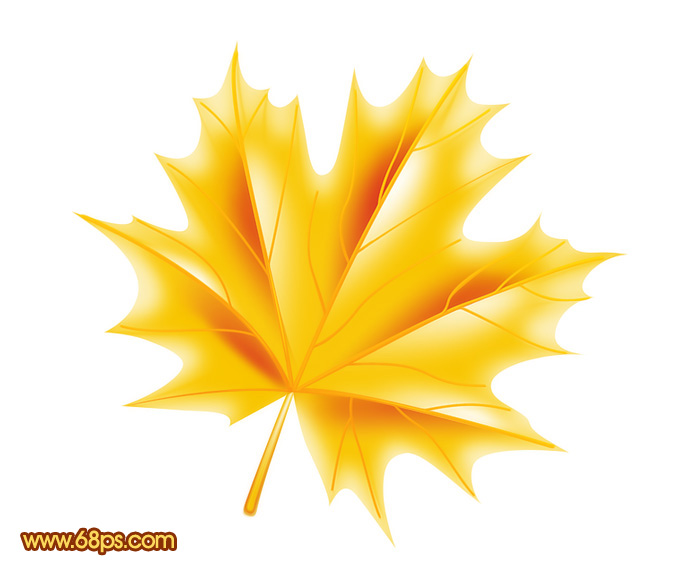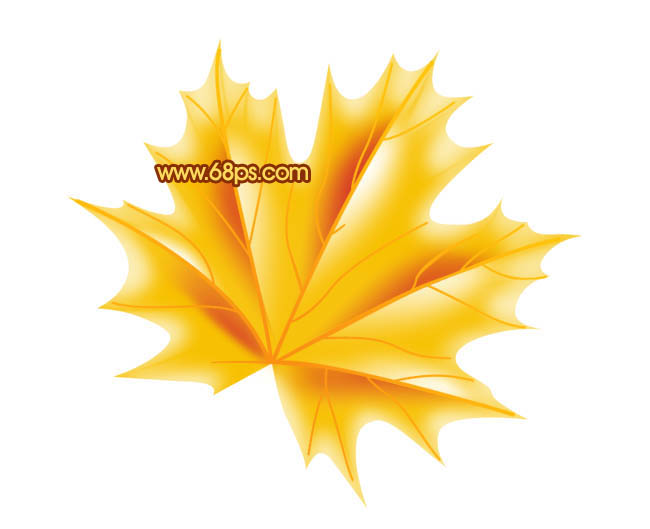Photoshop制作一片金色的水晶树叶
本教程介绍水晶树叶的制作方法。由于树叶是不规则物体,高光和暗调部分也是不太规则的。制作的时候需要根据树叶的形状特征慢慢渲染高光和暗调,这样做出的效果才更自然。
最终效果
1、新建一个800 * 600像素的文档,背景选择白色。新建一个图层用钢笔勾出叶子轮廓部分的路径,转为选区后填充橙色:#F7C000,效果如下图。
<图1>
2、新建一个图层,用钢笔勾出图2所示的选区,按Ctrl + Alt + D 羽化8个像素后填充颜色:#FBEDB4,作为叶子边缘的高光,然后按Ctrl + Alt + G 与前一图层编组,效果如图3。
<图2> 
<图3>
3、在当前图层下面新建一个图层,同上的方法制作出其它的边缘高光,如图4,5。
<图4> 
<图5>
4、新建一个图层,用钢笔勾出图6所示的选区,羽化1个像素后填充颜色:#F7C000,适当降低图层不透明度,效果如图7。
<图6> 
<图7>
5、同上的方法制作其它的边缘暗部,效果如下图。
<图8>
6、新建一个图层,用钢笔勾出图9所示的选区,羽化15个像素后随意填充一种颜色,效果如图10。
<图9> 
<图10>
7、锁定当前图层。用钢笔勾出图11所示的选区,选择渐变工具,颜色设置如图12,由上至下拉出线性渐变。确定后按Ctrl + Shift + I 把选区反选,设置渐变色如图13,把右边拉上线性渐变,效果如图14。
<图11> 
<图12> 
<图13> 
<图14>
8、其它中间部分的水晶效果的制作方法相同,有所不同的是底部的选区不太规则,不过原理和渐变色设置一样,效果如图15,16,17。
<图15> 
<图16> 
<图17>
9、新建一个图层,用钢笔勾出叶脉部分的选区如图18,如果不能一次性勾出路径,可以分层来勾。拉上图19所示的径向渐变,效果如图20。
<图18> 
<图19> 
<图20>
10、新建一个图层,用钢笔勾出叶脉高光部分的选区如图21,填充稍亮一点的颜色,效果如图22。
<图21> 
<图22>
11、叶子主体部分大致完成的效果如下图。
<图23>
12、在背景图层上面新建一个图层,用钢笔勾出叶柄部分的选区,拉上渐变色,底部稍微用减淡工具涂亮一点,效果如下图。
<图24>
13、新建一个图层,用钢笔勾出叶柄高光部分的选区,羽化1个像素后填充稍亮一点的颜色,再用减淡工具调整一下亮度,效果如图26。
<图25> 
<图26>
最终调整一下细节部分,完成最终效果。
<图27>

Hot AI Tools

Undresser.AI Undress
AI-powered app for creating realistic nude photos

AI Clothes Remover
Online AI tool for removing clothes from photos.

Undress AI Tool
Undress images for free

Clothoff.io
AI clothes remover

Video Face Swap
Swap faces in any video effortlessly with our completely free AI face swap tool!

Hot Article

Hot Tools

Notepad++7.3.1
Easy-to-use and free code editor

SublimeText3 Chinese version
Chinese version, very easy to use

Zend Studio 13.0.1
Powerful PHP integrated development environment

Dreamweaver CS6
Visual web development tools

SublimeText3 Mac version
God-level code editing software (SublimeText3)

Hot Topics
 1664
1664
 14
14
 1423
1423
 52
52
 1318
1318
 25
25
 1269
1269
 29
29
 1248
1248
 24
24
 Photoshop's Value: Weighing the Cost Against Its Features
Apr 11, 2025 am 12:02 AM
Photoshop's Value: Weighing the Cost Against Its Features
Apr 11, 2025 am 12:02 AM
Photoshop is worth the investment because it provides powerful features and a wide range of application scenarios. 1) Core functions include image editing, layer management, special effects production and color adjustment. 2) Suitable for professional designers and photographers, but amateurs may consider alternatives such as GIMP. 3) Subscribe to AdobeCreativeCloud can be used as needed to avoid high one-time spending.
 Advanced Photoshop Tutorial: Master Retouching & Compositing
Apr 17, 2025 am 12:10 AM
Advanced Photoshop Tutorial: Master Retouching & Compositing
Apr 17, 2025 am 12:10 AM
Photoshop's advanced photo editing and synthesis technologies include: 1. Use layers, masks and adjustment layers for basic operations; 2. Use image pixel values to achieve photo editing effects; 3. Use multiple layers and masks for complex synthesis; 4. Use "liquefaction" tools to adjust facial features; 5. Use "frequency separation" technology to perform delicate photo editing, these technologies can improve image processing level and achieve professional-level effects.
 Photoshop's Key Features: A Deep Dive
Apr 19, 2025 am 12:08 AM
Photoshop's Key Features: A Deep Dive
Apr 19, 2025 am 12:08 AM
Key features of Photoshop include layers and masks, adjustment tools, filters and effects. 1. Layers and masks allow independent editing of image parts. 2. Adjust tools such as brightness/contrast can modify image tone and brightness. 3. Filters and effects can quickly add visual effects. Mastering these features can help creative professionals achieve their creative vision.
 Using Photoshop: Creative Possibilities and Practical Uses
Apr 22, 2025 am 12:09 AM
Using Photoshop: Creative Possibilities and Practical Uses
Apr 22, 2025 am 12:09 AM
Photoshop is very practical and creative in practical applications. 1) It provides basic editing, repairing and synthesis functions, suitable for beginners and professionals. 2) Advanced features such as content recognition fill and layer style can improve image effects. 3) Mastering shortcut keys and optimizing layer structure can improve work efficiency.
 Is Photoshop Free? Understanding Subscription Plans
Apr 12, 2025 am 12:11 AM
Is Photoshop Free? Understanding Subscription Plans
Apr 12, 2025 am 12:11 AM
Photoshop is not free, but there are several ways to use it at low cost or free: 1. The free trial period is 7 days, and you can experience all functions during this period; 2. Student and teacher discounts can cut costs by half, and school proof is required; 3. The CreativeCloud package is suitable for professional users and includes a variety of Adobe tools; 4. PhotoshopElements and Lightroom are low-cost alternatives, with fewer functions but lower prices.
 Photoshop: Investigating Free Trials and Discount Options
Apr 14, 2025 am 12:06 AM
Photoshop: Investigating Free Trials and Discount Options
Apr 14, 2025 am 12:06 AM
You can get the access to Photoshop in the most economical way: 1. Experience the software features with a 7-day free trial; 2. Find student or teacher discounts, as well as seasonal promotions; 3. Use coupons on third-party websites; 4. Subscribe to Adobe CreativeCloud's monthly or annual plan.
 Photoshop and Digital Art: Painting, Illustration, and Compositing
Apr 18, 2025 am 12:01 AM
Photoshop and Digital Art: Painting, Illustration, and Compositing
Apr 18, 2025 am 12:01 AM
Photoshop's applications in digital art include painting, illustration and image synthesis. 1) Painting: Using brushes, pencils and mixing tools, the artist can create realistic effects. 2) Illustration: With vector and shape tools, artists can accurately draw complex graphics and add effects. 3) Synthesis: Using mask and layer blending mode, artists can seamlessly blend different image elements.
 Photoshop for Designers: Creating Visual Concepts
Apr 13, 2025 am 12:09 AM
Photoshop for Designers: Creating Visual Concepts
Apr 13, 2025 am 12:09 AM
Creating visual concepts in Photoshop can be achieved through the following steps: 1. Create a new document, 2. Add a background layer, 3. Use the brush tool to draw basic shapes, 4. Adjust colors and brightness, 5. Add text and graphics, 6. Use masks for local editing, 7. Apply filter effects, these steps help designers build a complete visual work from scratch.




